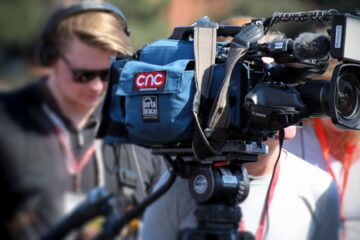![]()
Introduction:
The Cricket Association of Bengal (CAB) hosted the sixth nation International Cricket tournament in November 1993. This historic 1995 ruling by the Indian Supreme Court on the air concerns a dispute between the Ministry of Information and Broadcasting and the Cricket Association of Bengal over whether or not the Cricket Association was entitled to grant exclusive television broadcasting to a private organization instead of a Doordarshan. In response, the court examines whether or not Doordardhan could enjoy its control over the creation of terrestrial signals and should dominate their possession over telecasting or not telecasting them.
This disagreement took place in the context of the first days of economic liberalization. This saw the entry of private media in an economic liberalization which had been enter in the field of state-owned media monopoly that is AIR and Doordarshan. The issue was also originating what the public sphere and what body could make up the largest part of the Indian public. The claims made against Doordarshan, Doordarshan argued they had the largest audience reach and thus valid claim to perform monopoly regarding broadcasting.
Procedural History
The Cricket Association of the Bengal on 15 March 1993, has written a letter to the Director-General of Doordarshan stating that the country’s sixth international cricket tournament is scheduled to take place in November 1993 as part of its diamond jubilee celebration. Bengal Cricket Association and Doordarshan to submit an intimate offer for any two alternatives:
- Doordarshan intent to generate ‘Host Broadcaster Signal’ and also live streaming of every tournament match, or
- Any other party would create the ‘Host Broadcaster Signal’ and Doordarshan would simply buy the right to television broadcasting in India.
CAB emphasized in particular that, in either case, the foreign tv rights would remain with the cricket body. CAB agreed with the World Production Establishment (WPE), representing the interest of Trans World International (TWI), for telecast rights to all the matches. CAB raised the issue and stated that the offers received from abroad, and from TWI, were much higher than Rs 20 million. After that CAB came up with a set of suggestions.
- CAB requested Doordarshan to convey the final decision in the matter before 21 October.
- On 27 October Doordarshan informed CAB that the phrases and situation of its renewed provide of 18 October have been now no longer acceptable and DD responded to CAB that they might now no longer take indicators from TWI, an overseas organization.
- On 8 November CAB recorded a summons request within the Calcutta Tall Court imploring, that the respondents should be coordinated to supply telecast and broadcast of all matches and give all offices for telecasting and broadcasting of the matches.
- On 15th November DD requested a scorn request within the high court against CAB and another.
Airwaves a Public Property
Radio waves are public property and should be used to promote the public interest. Their use must be controlled and regulated by the public sector for the benefit of the public and to prevent interference with their rights. No one has the right to use them at his choice and his discretion and for his choice, including profits either can be used by citizens for broadcasting. Since broadcasting is public, the State needs to ensure that it is used in a way that promotes freedom of expression for its citizens by ensuring a diversity of opinions and ideas.
Issues
- Did the organizer have the right to air through a foreign institution?
- Do government agencies monopolize the generation and broadcasting of terrestrial signals or their rejection?
- Is either the airwaves or frequencies come under the public domain or public property?
- Can a government agency like DD claim to be the host broadcaster for all events, whether the event is produced or organized by themselves or someone else in the country?
Arguments
Argument of Ministry of Information and Broadcasting
The difference in the impact of the rights conferred under section 19(1) (a) on persons wishing the media to evaluate their views, including (i) broadcasters and (ii) organizers have. With respect to the event (iii) the viewer (IV) seeks a television signal and frequency connection generated elsewhere in India.
Broadcasters themselves do not have access to it without a broadcasting license. There are no general claims about broadcast licenses. It either should be used as a limited resource to provide maximum benefit.
The right to watch television/radio is subject to certain natural restrictions, but Article 19 (2) applies to the restrictions imposed by the government. The purpose of the license is not to limit the expression of ideas, but to regulate and order scarce resources by including people who are not wealthy enough to dominate the media to ensure optimal enjoyment.
The monopoly of television broadcasts does not in itself prohibit the monopoly of ideas, otherwise, the fact that access to the media is through state authorities violates Article 19 (1).
Argument of Cricket Association of Bengal
The right to host a sporting event rests with the legal entity to which it belongs, in which case the legal entity is its member, including the Board of Control for Cricket in India and the Cricket Association of Bengal. The right to create an event includes the right to edit the event the way your company chooses. This includes the right to broadcast and not broadcast the event.
BCCI and CAB had the right to produce, broadcast, transmit the event, either directly or through an agent, under Section 19 (1) (a). The content of the rights under Article 19 (1) (a) is also sufficient to protect the viewer’s information. In this case, the viewer and producer had the right to broadcast the event. Given these two rights; the telecommunications bureau was obliged to allow the event to be broadcast.
Licensing under Section 4 of the Act is a regulatory measure and does not authorize the MIB to deny the Board of Control for Cricket in India/Cricket Association of Bengal a license to broadcast and broadcast sporting events or impose conditions unrelated to Section 19(2).
The Constitution does not provide for monopoly in section 19(1) (a). Therefore, Doordarshan cannot make the same claim, and Doordarshan’s claims of commercial interests or exclusive rights in the generation of signals cannot be grounds for refusal of approval under section 4 of the Act.
Judgement
- Radio waves and frequencies had to be treated as public goods. Their use should be monitored and regulated by government agencies for the public good and to prevent the invention of their rights. Because electronic media involves the use of radio waves, this factor places restrictions on the use of radio waves as it does with other public property.
- The Supreme Court has found that the right to communicate and receive information is a form of the right to freedom of expression and freedom of expression guaranteed by Article 19(1) (a) of the Constitution. Citizens have the basic right to receive information and to access television broadcasts for this purpose. Radio waves have been involved in law enforcement and can be monitored and regulated by government agencies. This restriction was imposed due to the nature of state ownership in relation to the use of electronic media in relation to restrictions on freedom of speech and expression in accordance with Article 19(2) of the Constitution.
- The Supreme Court has ruled that the central government will take immediate steps to create an independent and autonomous government agency that represents all sectors and interests of society to control and regulate the use of radio waves.
- The Supreme Court has stated that diversity of opinions, views, and ideas cannot be guaranteed in an environment controlled by a monopoly, whether it belongs to the state or to another person, group, or organization. “Private broadcasters may be more likely to infringe upon citizens’ freedom of speech than state-run media, as outlined in the statute. Broadcasting media should be controlled by the public, not by the government. This mark is implied in Article 19(1) (a)” of the constitution.
Conclusion
Knowledge is power. Information is the foundation of knowledge. It is not wrong to say that information is directly related to authorization. Empowering people in a democracy is essential to successful governance.
There is an inseparable relationship between freedom of the press and the stability of society, that is, the stability of the nation-state.
The right to freedom of speech and expression includes the right to receive and communicate information. In order to guarantee the citizen’s right to freedom of expression, citizens must utilize different views and different opinions on all public matters. Successful democracy presupposes “informed” citizens. Private broadcasters are more vulnerable to citizens’ freedom of expression than state-controlled media. Broadcasting media should be controlled by the public, not by the government. This mark is implied in Article 19(1) (a). The law must present news, views, and opinions in a balanced manner, and must ensure the pluralism and diversity of opinions and views.



0 Comments